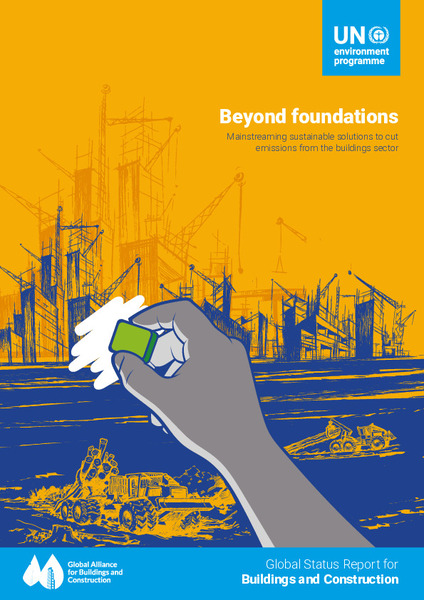| dc.contributor | Economy Division | en_US |
| dc.contributor.author | United Nations Environment Programme | en_US |
| dc.contributor.author | International Energy Agency | en_US |
| dc.date.accessioned | 2019-12-11T09:38:08Z | |
| dc.date.available | 2019-12-11T09:38:08Z | |
| dc.date.issued | 2019 | |
| dc.identifier.isbn | 978-92-807-3768-4 | en_US |
| dc.identifier.other | DTI/2265/PA | en_US |
| dc.identifier.uri | https://wedocs.unep.org/20.500.11822/30950 | |
| dc.description | The buildings and construction sector accounted for 36% of final energy use and 39% of energy and process-related carbon dioxide (CO2) emissions in 2018, 11% of which resulted from manufacturing building materials and products such as steel, cement and glass. This year’s Global Status Report provides an update on drivers of CO2 emissions and energy demand globally since 2017, along with examples of policies, technologies and investments that support low-carbon building stocks. The key global buildings sector trends are: • Global buildings sector emissions increased 2% from 2017 to 2018, to reach a record high, while final energy demand rose 1% from 2017 and 7% from 2010. • Increases were driven by strong floor area and population expansions. While efficiency improvements continued to be made, they were not adequate to outpace demand growth. • 2020 is a key year for countries to enhance their Nationally Determined Contributions (NDCs), especially concerning further actions to address energy use and emissions including embodied emissions in the buildings and construction sector. • Countries are innovating and implementing measures to improve efficiency and reduce emissions from their building stock. As sharing effective measures globally would amplify their impact, regional roadmaps are being developed for this purpose. | en_US |
| dc.format | Text | en_US |
| dc.language | English | en_US |
| dc.relation.ispartof | Global Status Report for Buildings and Construction | en_US |
| dc.rights | Public | en_US |
| dc.subject | building | en_US |
| dc.subject | construction industry | en_US |
| dc.subject | construction | en_US |
| dc.subject | energy efficiency | en_US |
| dc.subject | sustainable consumption | en_US |
| dc.subject | sustainable energy | en_US |
| dc.subject | green building | en_US |
| dc.subject | construction industry | en_US |
| dc.subject | building material | en_US |
| dc.subject | circular economy | en_US |
| dc.title | 2019 Global Status Report for Buildings and Construction: Towards a Zero-emissions, Efficient and Resilient Buildings and Construction Sector | en_US |
| dc.type | Publications | en_US |
| dc.type | Technical Reports | en_US |
| wd.identifier.sdg | SDG 7 - Affordable and Clean Energy | en_US |
| wd.identifier.sdg | SDG 9 - Industry, Innovation and Infrastructure | en_US |
| wd.identifier.sdg | SDG 11 - Sustainable Cities and Communities | en_US |
| wd.identifier.sdg | SDG 12 - Responsible Consumption and Production | en_US |
| wd.identifier.sdg | SDG 13 - Climate Action | en_US |
| wd.tags | Buildings | en_US |
| wd.tags | Energy Efficiency | en_US |
| wd.topics | Finance and Economic Transformations | en_US |
| wd.topics | Resource Efficiency | en_US |
| wd.identifier.pagesnumber | 41 pages | en_US |





